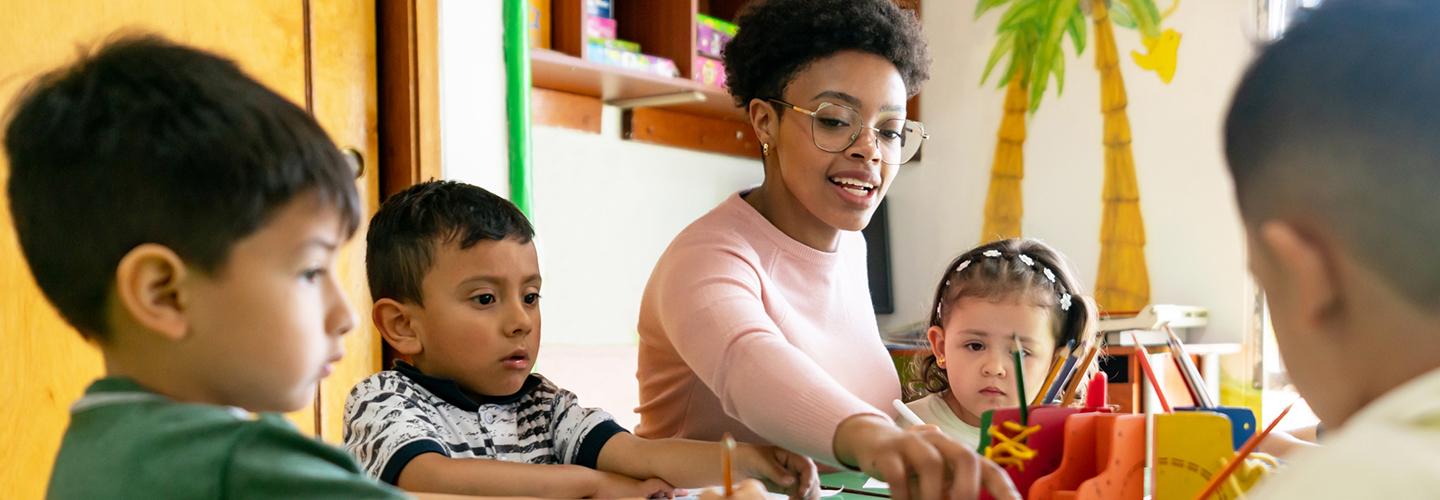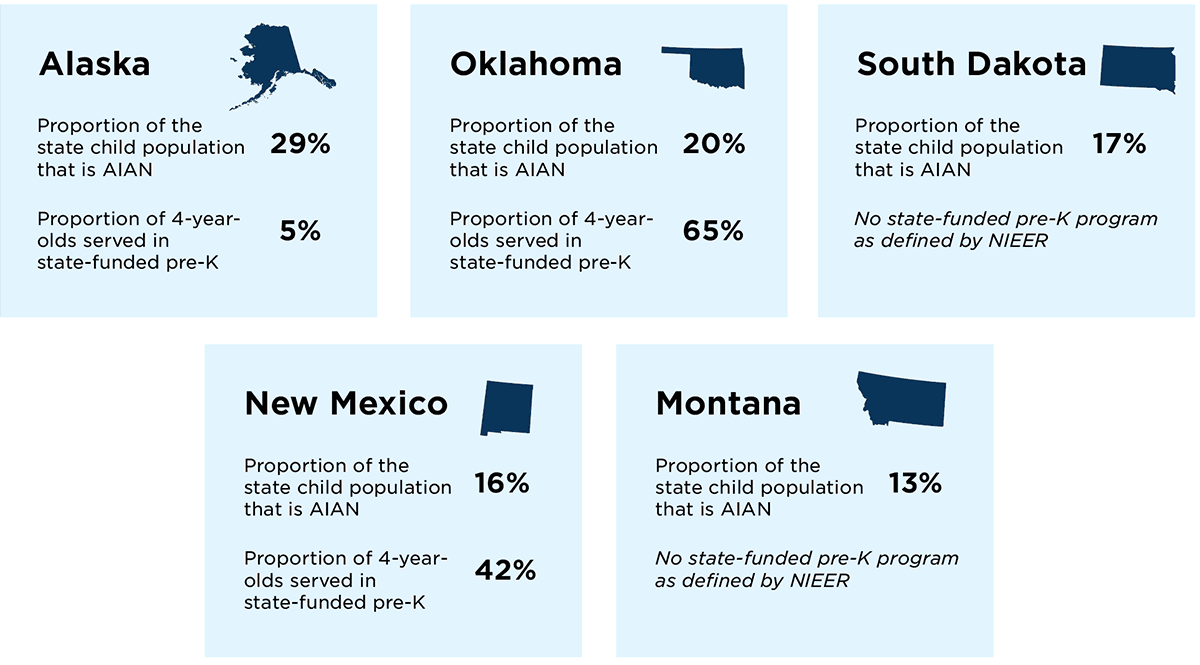
Pre-K May Be Critical to Academic Success for American Indian and Alaska Native (AIAN) Children
Improving children’s educational outcomes requires equity-focused solutions that increase access to early learning environments and support the full range of students within a community. Lessons from Tulsa, Oklahoma’s implementation of the Oklahoma universal[1] pre-kindergarten (pre-K) program—drawn from a study of over 4,000 students in Tulsa, OK that sought to understand the short-, intermediate-, and longer-term effects of pre-K—can inform efforts to provide early educational support to students, and especially to American Indian and Alaska Native (AIAN) students. Thanks to Tulsa’s relatively large number of AIAN students, this study is unique in its ability to shed light on the educational experiences of AIAN students nationwide, who may face unique challenges and bring unique strengths to the classroom.
In Tulsa, children enrolled in the universal pre-K program have experienced sustained positive outcomes through high school and postsecondary education, with remarkable benefits for AIAN students who attended pre-K. This brief expands on the findings of the Tulsa pre-K study and discusses how universal pre-K offers a promising avenue for supporting the academic success of AIAN students. We also offer recommendations to help researchers, Tribal and school leaders and educators, and policymakers better meet AIAN students’ academic needs.
Overview of AIAN Children in the United States
AIAN[2] children[3] represent approximately 3 percent of the U.S. child population, but national population estimates mask considerable variation in the AIAN child population by state, with AIAN children comprising 15-30 percent of the child population in some states (see the figure below). Most of these AIAN children (an estimated 93%) are enrolled in public schools. Moreover, some states with a high proportion of AIAN children offer public pre-K, which may have significant benefits for AIAN students. In 2022, about 1.5 million children were enrolled in state pre-K programs in the United States, with Oklahoma ranked third in terms of preschool access for 4-year-olds. The figure displays the five states with the highest proportion of AIAN children and the respective rates of children in pre-K, demonstrating a wide variation in pre-K access in states with high proportions of AIAN children. According to the National Institute for Early Education Research (NIEER), Oklahoma is the only state out of the five listed in the figure with a universal pre-K program serving about two thirds of the 4-year-olds in the state.
Download

Note: State-funded pre-K can include universal and targeted pre-K. Targeted pre-K focuses pre-K eligibility to specific populations, such as children from lower-income households or those who are English language learners.
Data for the figure were gathered from the 2021 1-year estimates of the ACS survey, conducted by the Census Bureau, and from the 2022 State Preschool Yearbook by the NIEER.
Universal Pre-K May Especially Benefit AIAN Students
Many AIAN students face barriers to academic success, such as school environments that are not aligned with AIAN cultural values and languages, the effects of child and community-level poverty, and difficulty accessing resources and support. As a result, federal and state policymakers are increasing attention to and investment in early childhood programs and services that may mitigate the educational inequities often faced by AIAN students and families. Programs like Tribal Maternal, Infant, and Early Childhood Home Visiting (MIECHV), Tribal Head Start, and language immersion schools are important investments that facilitate access to culturally appropriate early care and education for AIAN children. Tribal Head Start serves over 44,000 children of AIAN heritage, and such targeted programs can also help non-AIAN children who face greater needs, such as students from low-income families or students with disabilities.
These tailored, Tribally managed programs are critical to the educational success of AIAN children. However, their geographic location and/or available resources may mean that they are not always available or accessible to all AIAN children and families. In fact, AIAN children and families are often served by non-Tribally managed public programs; as discussed earlier, the majority of AIAN children are enrolled in public schools. Therefore, tailoring these publicly available educational programs and supports available to AIAN students is critical for their academic success.
Current research suggests that pre-K improves school readiness and contributes to positive academic long-term outcomes. More specifically, the Tulsa pre-K study followed students over two decades, illustrating positive and unique outcomes for students that were enrolled in pre-K. The results illustrated that pre-K program impacts are more favorable for AIAN students than for students from other racial/ethnic backgrounds examined in the study.
In the Tulsa pre-K study, pre-K is favorably associated with middle, secondary, and post-secondary outcomes for AIAN students, including increased attendance, greater likelihood of taking honors coursework, and higher state standardized test scores in middle and high school. In other words, the Tulsa findings suggest that pre-K enrollment is correlated with positive and sustained outcomes for AIAN children. While the Tulsa pre-K study and other studies—for example, in Maryland and New Jersey—have shown the benefits of pre-K for all students, Tulsa’s specific findings for AIAN students suggest that greater attention to universal pre-K programming may be an important avenue for supporting the academic success of AIAN students.
Recommendations
The following recommendations for researchers, Tribal and school leaders and educators, and policymakers are informed by research findings for AIAN students from the Tulsa pre-K study and by the educational needs of AIAN students.
Researchers
The Tulsa pre-K study demonstrated important findings for AIAN students, but researchers were not able to understand and draw conclusions as to why the associations may have differed. Future research can incorporate the learnings and shortcomings of the study as a guide.
Researchers should disaggregate student data as much as possible when evaluating education programs such as universal pre-K. This can help them better understand the experiences of children across various backgrounds.
When a study includes unique findings for a subgroup of students, such as the findings for AIAN students in the Tulsa pre-K study, researchers should work with that community to gain greater clarity around the findings. This collaborative work can guide next steps for building evidence around the potential benefits of pre-K and how pre-K can best be delivered to meet the needs of students in that community.
- For example, findings from the Tulsa pre-K study for AIAN students indicate a need for further research to understand how programming contributes to positive results for AIAN students. Researchers could partner with local Tribal leaders, educators, and families for a more thoughtful understanding of what aspects are beneficial for AIAN children and how those benefits can be maximized.
Tribal and school leaders and educators
Many AIAN students attend public schools where the supports and resources available may not be tailored to adequately meet their needs. Based on the Tulsa pre-K study findings, universal pre-K can serve as one way to build positive academic outcomes for AIAN students.
Tribal leaders and educators should connect and partner with local and state education officials, especially in localities with high AIAN populations, to advocate for universal pre-K and ensure that programs are tailored to the needs of AIAN students and families.
Public school leaders and administrators in areas with high proportions of AIAN students should connect and coordinate with Tribal leaders and organizations to ensure that programs and services meet the needs of these students.
Policymakers
The Tulsa study highlights the importance of pre-K programs for AIAN students and can inform policymakers’ decisions about the educational programming they support for families with young children.
Federal, state, and local policymakers should use research and data to inform pre-K expansion efforts to ensure that all students have equitable access to pre-K and that programs support their educational growth.
- More specifically, states like South Dakota and Montana that have high proportions of AIAN children should consider investing in public universal pre-K to support the academic success of AIAN and other students.
As policymakers at all levels grow their investments in pre-K, they should also fund data collection and evaluation of pre-K programs so that any gaps can be identified and addressed.
State policymakers must also partner with Tribal leaders and educators to meet the needs of AIAN students in public school settings.
Acknowledgements
We would like to acknowledge Diana Cournoyer from the National Indian Education Association for their contribution in helping conceptualize and formulate this product.
Download
Footnotes
[1] The National Institute for Early Education Research (NIEER) defines a universal pre-K program as one in which every child is eligible to enroll and the only criteria is age.
[2] Defined as American Indian and Alaska Native alone or in combination with one or more other races by the U.S. Census Bureau
[3] Defined as people under age 18
Suggested citation
Patel, A., Amadon, S., & Around Him, D. (2023). Pre-K may be critical to academic success for American Indian and Alaska Native (AIAN) children. Child Trends. https://doi.org/10.56417/6582m1357z
© Copyright 2024 ChildTrendsPrivacy Statement
Newsletter SignupLinkedInThreadsYouTube